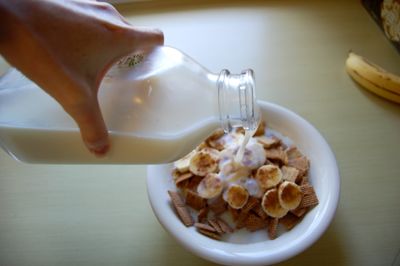by Larry
November, 2016Bugging Out Over Cockroach Milk
Actually, Barbara Stay, a professor emerita at the University of Iowa (previously considered dairy cattle country) began studying this insect's milk, which turns to crystals inside the bug's embryos. She switched filter paper for embryos in the adult females' brood sacks, left it there awhile, and when she took it out again she got milk, a process she calls "milking a cockroach." This method would have to be repeated thousands or millions of times, though, to get a bottle of milk for a human infant, so do not look for cockroach milk soon in your local supermarket. Undaunted, Subramanian Ramaswamy, heading a biochemistry research team in Bangalore, India, analyzed the nutritional value of the cockroach's milk crystals and was surprised to find the above referenced phenomenal richness of the arthropod's nutrient secretions. Alas, much further study will be required to assure that Pacific Beetle Cockroach milk is safe for Homo sapiens to ingest. Time will also be required to develop a synthetic variety that can be produced more economically, perhaps using genetically engineered yeast. One day, though, compounds of milk originally created to feed young cockroaches may well show up in our health food aisles, maybe to be spooned over our breakfast yogurt or mixed into baby formulas. New generations of over 100 years young folks may credit their longevity to copious consumption of cockroach milk. Primary source: Cockroach Milk: Yes. You Read That Right. Emerald Alexis Ware in www.npr.org; August 6, 2016. |
 One can imagine the scientists and their graduate assistants out in barns milking a variety of creatures, trying out the different species till they had found just the best life form for this sort of thing. Scorpions?...No. Eels?...No. Hummingbirds?...No. Blue whales?...No. Leopard frogs?...No. Platypuses?...No. Asian elephants?...No. Crocodiles?...No. Slime molds?...No. Octopi?...No. Pacific Beetle Cockroaches?...Yes! How many did they have to go through before success? Grad. students, that is. Surely this sort of work is not for the faint of heart. And does it require any special technique? Just how delicate is it to milk a cockroach?
One can imagine the scientists and their graduate assistants out in barns milking a variety of creatures, trying out the different species till they had found just the best life form for this sort of thing. Scorpions?...No. Eels?...No. Hummingbirds?...No. Blue whales?...No. Leopard frogs?...No. Platypuses?...No. Asian elephants?...No. Crocodiles?...No. Slime molds?...No. Octopi?...No. Pacific Beetle Cockroaches?...Yes! How many did they have to go through before success? Grad. students, that is. Surely this sort of work is not for the faint of heart. And does it require any special technique? Just how delicate is it to milk a cockroach?